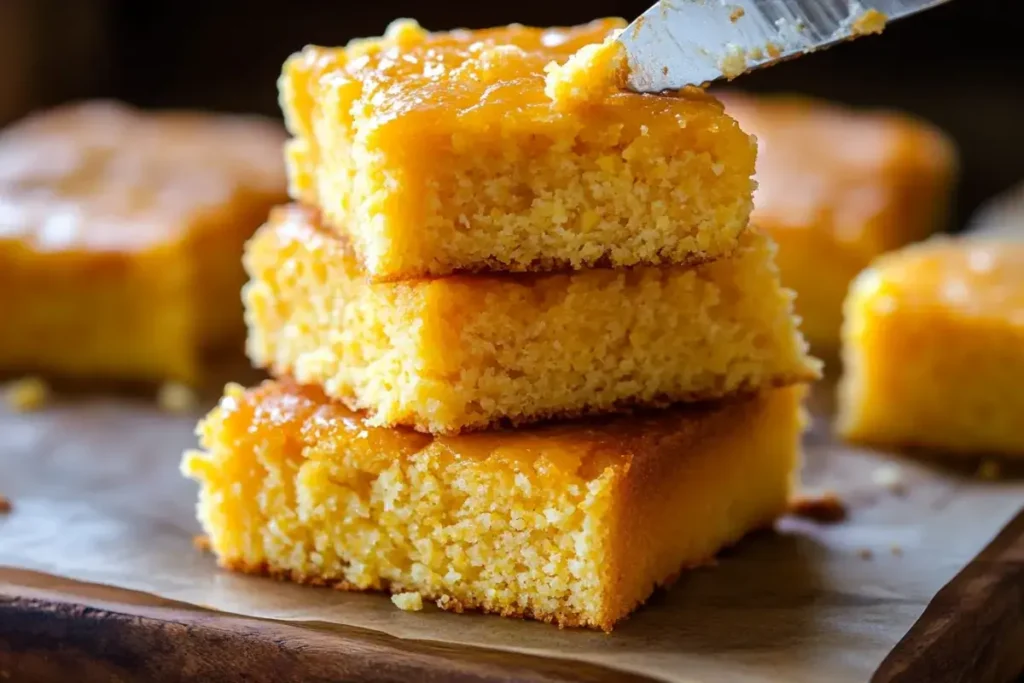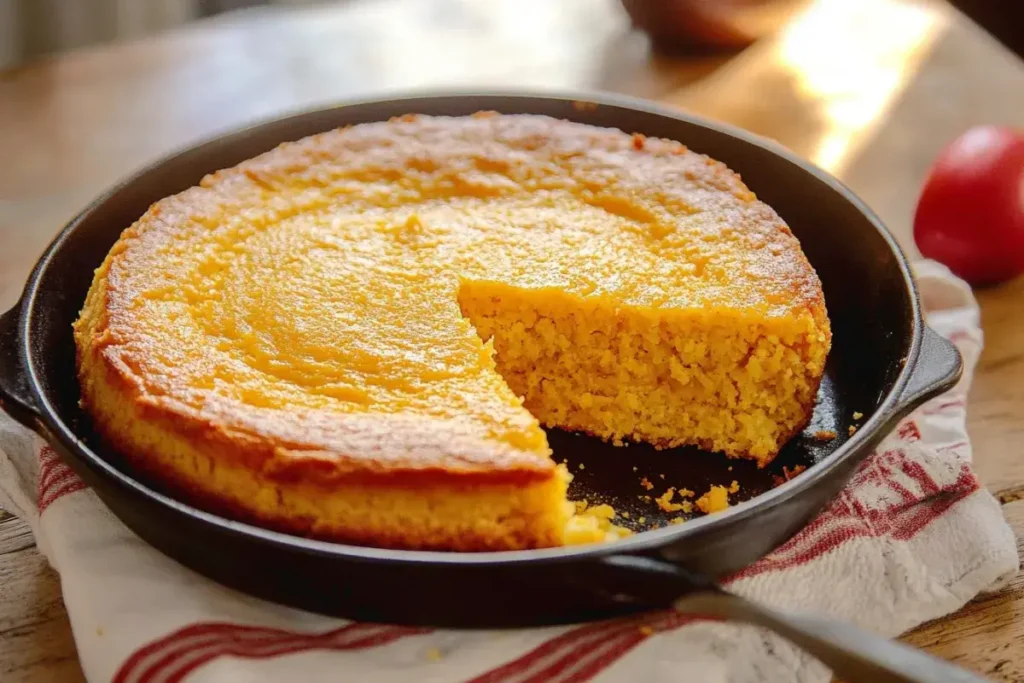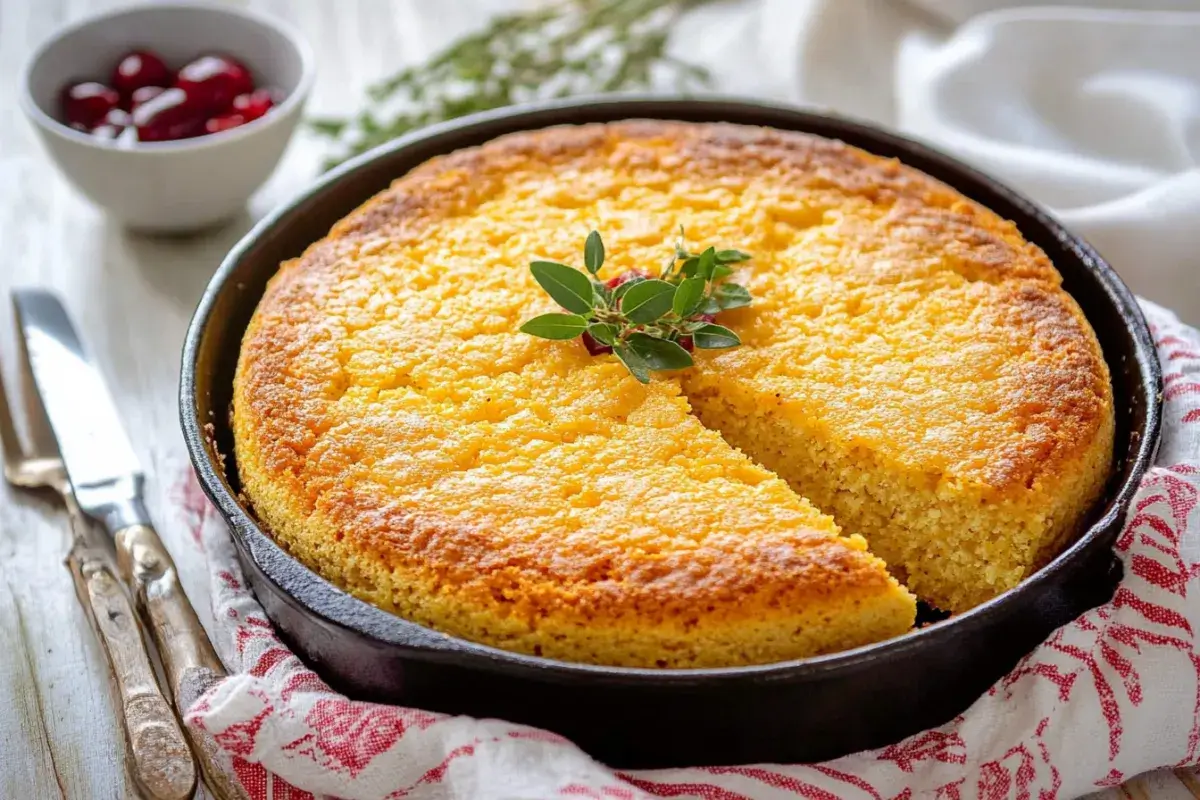Cornbread is a classic American dish, but it exists in two major styles: Southern cornbread and sweet cornbread. Both types rely on cornmeal, yet the differences in texture, taste, and even preparation set them apart. Let’s explore these differences to help you decide which one best fits your preferences.
1. Introduction to Cornbread
Cornbread has been a staple in American kitchens for centuries, with Southern vs sweet cornbread being the two most popular styles. While Southern cornbread is savory, sweet cornbread offers a lighter, sweeter experience. Although they share a common base, these two versions reflect distinct regional flavors.
2. History of Cornbread
To understand the key differences, it’s helpful to look at cornbread’s history. Native American tribes first created simple cornmeal bread. Early European settlers later adapted the recipe, adding flour and other ingredients to make it rise. Over time, this basic recipe evolved into Southern and sweet cornbread.
In the South, the dish remained simple, using only a few ingredients like cornmeal and buttermilk. Meanwhile, Northern cooks began adding sugar to the recipe, which resulted in the sweet cornbread we know today. For more details, check out this History of Cornbread.
3. Ingredients Comparison: Southern Cornbread vs. Sweet Cornbread
Although both styles share a core ingredient—cornmeal—their supporting ingredients lead to different results:
- Cornmeal Type: Southern cornbread typically uses coarse-ground cornmeal, which gives it a grittier texture. By contrast, sweet cornbread calls for fine-ground cornmeal, making it softer and lighter.
- Flour and Sugar: Southern cornbread often skips flour and sugar, leading to a dense, savory bread. On the other hand, sweet cornbread includes both flour and sugar, making it lighter and sweeter. You can check out a modern take on this recipe by visiting this Cornbread Recipe.
- Fats and Liquids: Southern recipes use butter or oil with buttermilk to add a tangy flavor. In contrast, sweet cornbread might use vegetable oil or melted butter for a neutral taste.
4. Cooking Techniques for Southern vs Sweet Cornbread
Both Southern vs sweet cornbread require specific cooking methods to achieve their signature textures.
- Cast-Iron Skillet: Southern cornbread is often baked in a preheated cast-iron skillet. This technique produces a crispy, golden crust, which contrasts nicely with the dense, crumbly interior. The heat from the cast iron evenly distributes and helps develop that perfect crust.
- Baking Dish: In contrast, sweet cornbread is usually baked in a square or rectangular baking dish. This results in a lighter, fluffier texture without the crispy edges. Sweet cornbread complements savory dishes, offering a softer contrast.
5. Texture and Flavor: Southern Cornbread vs Sweet Cornbread
The main difference between Southern cornbread and sweet cornbread lies in their texture and flavor.
- Southern Cornbread: Known for its crumbly texture, Southern cornbread has a savory taste, thanks to its lack of sugar. The coarse cornmeal gives it a gritty texture, while cooking it in a skillet produces a crispy crust. It pairs perfectly with hearty dishes, absorbing stews or soups well.
- Sweet Cornbread: In contrast, sweet cornbread has a soft, moist texture, almost cake-like. Adding sugar and flour creates a light, fluffy consistency. Its sweetness pairs well with bold, spicy dishes, such as chili or barbecued meats.
6. Regional Variations of Cornbread
Cornbread comes in various forms across the United States, depending on the region.
- Appalachian Cornbread: This Southern variety often excludes flour, which results in a denser, more rustic bread. It reflects the simplicity and affordability of local ingredients in the Appalachian region.
- Lowcountry Cornbread: In coastal regions like South Carolina, Lowcountry cornbread uses stone-ground white cornmeal. This version is smoother, with a lighter, slightly sweeter flavor without added sugar.
7. Southern Cornbread in Southern Culture
In Southern culture, cornbread represents more than just a side dish. It holds deep roots in family traditions and regional gatherings, symbolizing comfort and simplicity. Made with basic, affordable ingredients, Southern cornbread is a staple at family dinners, holidays, and community events. Its crumbly texture pairs well with hearty dishes like greens or stews, soaking up their rich flavors.
8. Sweet Cornbread and Northern Traditions

Meanwhile, sweet cornbread has strong ties to Northern and Midwestern traditions. As sugar and flour became more accessible in these regions, the recipe adapted, resulting in a lighter, sweeter bread. Sweet cornbread commonly appears at barbecues, potlucks, and holiday dinners. Its soft texture and sweet flavor provide a pleasant contrast to bold, savory foods.
Understanding the differences between Southern and sweet cornbread highlights the regional diversity within American cuisine. Whether you enjoy the savory crunch of Southern cornbread or prefer the fluffy sweetness of sweet cornbread, both styles have become cherished parts of the American food landscape.
9. How to Pair Cornbread with Meals
Both Southern and sweet cornbread have unique flavors and textures that make them ideal accompaniments for various dishes. Here’s how you can pair each type:
- Southern Cornbread: Its crumbly, savory nature pairs best with hearty, rich dishes. You can serve it with chili, soups, or stews, where the bread can soak up flavorful broths and sauces. Southern cornbread also complements barbecued meats, greens, and beans, adding a satisfying contrast with its crispy edges.
- Sweet Cornbread: Thanks to its lighter texture and sweetness, sweet cornbread works well with spicy or bold-flavored foods. For example, serving it with spicy chili or barbecued chicken enhances the flavor contrast. It also goes well with fried chicken, providing a sweet balance to the savory elements of the dish.
10. Health Aspects of Southern and Sweet Cornbread
While neither version of cornbread is particularly low in calories, each offers different nutritional profiles.
- Southern Cornbread: Since this type typically leaves out sugar, it contains fewer carbohydrates from sweeteners. However, Southern cornbread may include butter or oil, which adds richness and calories. It’s also often denser, which means it can be more filling.
- Sweet Cornbread: This version includes sugar, making it higher in carbohydrates and calories. The added flour also makes it lighter and less dense, but the sweetness contributes to an overall higher calorie count. If you’re looking to make this version healthier, you could experiment with reducing the sugar or using alternative flours.
11. Modern Adaptations and Variations
As times have changed, so have the ways people prepare both types of cornbread. Today, you’ll find endless variations of the basic recipes that cater to different dietary needs and preferences.
- Gluten-Free Cornbread: With the rise of gluten-free diets, many recipes now substitute traditional flour with gluten-free alternatives. This adaptation allows people with gluten sensitivities to enjoy both Southern and sweet cornbread.
- Dairy-Free Cornbread: Many modern recipes have adapted to remove dairy, using alternatives like almond milk or coconut milk instead of buttermilk. This allows those with lactose intolerance to still enjoy the classic flavor of cornbread.
- Cornbread Muffins: For individual servings, many people turn to cornbread muffins. These are often made from the same batter as sweet cornbread but baked in muffin tins. This convenient version is popular at potlucks and family dinners.
- Jalapeño Cornbread: This spicy version of cornbread adds chopped jalapeños for a kick. It can be found in both Southern and sweet styles and pairs especially well with bold dishes like chili.
For another twist, you can try this Sweet Potato Cornbread Recipe, which adds a hint of sweetness and extra moisture from the sweet potatoes.
12. The Debate: To Add Sugar or Not?
One of the longest-running debates among cornbread lovers is whether to add sugar. Southern cornbread purists argue that sugar doesn’t belong in traditional cornbread, as it was historically made without sweeteners. On the other hand, many enjoy the balance of sweetness that sugar provides, particularly in Northern and Midwestern variations. This debate continues today, with some recipes including a little sugar to suit modern palates.
Whether you prefer cornbread with or without sugar ultimately comes down to personal taste. However, many Southern recipes stick to the original, no-sugar method to honor tradition.
13. Serving and Storing Cornbread
Cornbread is best when served warm, but there are plenty of ways to enjoy it even after it has cooled. Here are some tips for serving and storing both Southern and sweet cornbread:

- Serving Suggestions:
- Southern cornbread is often served alongside hearty meals like beans, stews, or chili. You can drizzle it with honey or serve it with butter for an extra layer of flavor.
- Sweet cornbread can be served as a side for spicy dishes, or enjoyed on its own as a snack or dessert. Its fluffy texture also makes it a great base for toppings like whipped butter or fruit jams.
For a richer and softer version, consider trying a Sweet Potato Cornbread recipe, which complements both sweet and savory meals.
- Storing Cornbread:
- You can store cornbread at room temperature for up to three days. Simply wrap it tightly in plastic wrap or place it in an airtight container.
- For longer storage, freeze individual slices. Wrapped in plastic and placed in a freezer-safe bag, frozen cornbread can last for up to two months. When you’re ready to eat it, just reheat in the oven or microwave.
14. Conclusion
The choice between Southern cornbread and sweet cornbread comes down to personal preference. Each type has its own rich history, distinct flavor, and unique texture. Southern cornbread offers a savory, crumbly bite perfect for soaking up the juices of hearty dishes, while sweet cornbread provides a light, fluffy, and slightly sweet contrast to spicy meals.
Whichever style you prefer, both have secured their places as timeless staples in American cooking.
15. FAQs
1. Can I substitute regular milk for buttermilk in cornbread?
Yes, you can use regular milk instead of buttermilk, but the cornbread will have a less tangy flavor. To mimic the acidity of buttermilk, you can add a tablespoon of lemon juice or vinegar to a cup of regular milk and let it sit for 5 minutes.
2. How do I make my cornbread fluffier?
For fluffier cornbread, try adding an extra egg to the batter or increasing the amount of baking powder. This will give the bread more lift during baking.
3. How can I get a crispy crust on my Southern cornbread?
To get a crispy crust, make sure to preheat your cast-iron skillet before pouring in the batter. The hot skillet helps form that signature crunchy crust.
4. Can cornbread be made gluten-free?
Yes, you can make gluten-free cornbread by using gluten-free cornmeal and substituting all-purpose flour with a gluten-free alternative.
5. Can you freeze leftover cornbread?
Absolutely. You can freeze cornbread by wrapping it tightly in plastic wrap and placing it in a freezer-safe bag. It will last for up to two months in the freezer.

